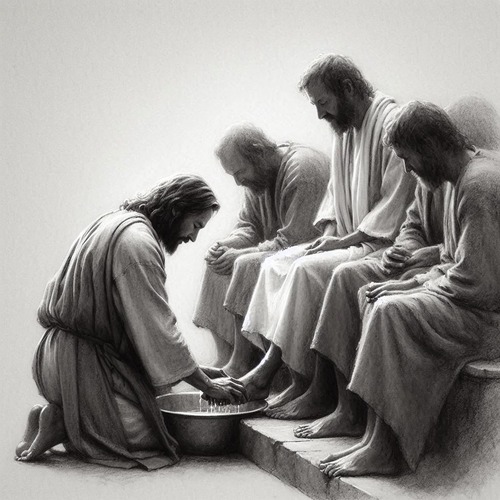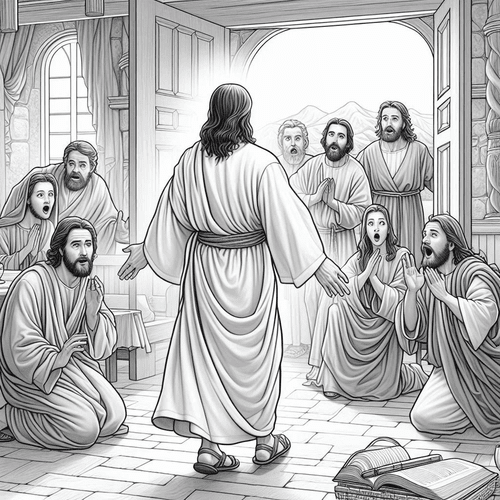The Kenosis: What Does It Mean that Jesus Emptied Himself?
“He emptied himself.” These three words from Philippians 2:7 capture one of Christianity’s most profound mysteries—the moment when the eternal Son of God voluntarily set aside His heavenly glory to become human. This act of divine self-emptying, known in theological terms as the kenosis, stands at the heart of our understanding of Christ’s incarnation.
The implications are staggering. The same divine Word who spoke the universe into existence took on human flesh. The One who holds all things together allowed Himself to be held in a mother’s arms. The King of kings became a servant.
But what exactly did Christ “empty himself” of? Did He temporarily stop being God? Did He give up His divine powers? These aren’t merely academic questions. How we understand Christ’s self-emptying shapes our view of who Jesus is, what He accomplished, and what it means to follow Him today. Let’s explore this crucial doctrine from a Reformed perspective, uncovering its rich implications for our faith and practice.
Kenosis: Jesus Emptied Himself—Understanding the Biblical Context
The term kenosis comes from the Greek word “ekenōsen” found in Philippians 2:7. This passage, often called the Carmen Christi or Christ’s Hymn, presents one of Scripture’s most magnificent descriptions of Christ’s incarnation. Paul frames this self-emptying not as Christ’s diminishment, but as the supreme demonstration of His divine nature expressing itself in humble service.
This context proves crucial because various interpretations throughout church history have misunderstood Christ’s self-emptying as a surrender of His divine attributes. Such views, while attempting to grapple with the mystery of the incarnation, ultimately undermine the full deity of Christ and contradict the biblical witness.
The Reformed Understanding of Christ’s Self-Emptying
The Reformed tradition, following the ancient church’s understanding, sees Christ’s kenosis not as subtraction but addition. Rather than surrendering divine attributes, Christ added to Himself a complete human nature while retaining every aspect of His deity. This aligns with the Westminster Confession’s careful articulation of Christ’s two natures—fully God and fully man, without confusion or separation. (Read Our Post: Why do We Affirm Jesus is Fully God and Fully Man?)
Think of it as veiling rather than voiding. Christ voluntarily accepted the limitations of human existence while retaining His full divine nature. Like a king who chooses to live as a commoner while remaining truly royal, Christ accepted human constraints while remaining truly divine. John Calvin described this as divine accommodation—God limiting Himself to work within human capacity without surrendering His divine nature.
What Christ Actually “Emptied Himself” Of
So what did Christ empty Himself of? Not His divine nature or attributes, but rather their independent exercise and visible manifestation. He laid aside:
- The glory and honour of heaven: Trading heaven’s worship for earth’s rejection
- The visible display of divine majesty: Accepting the appearance of ordinary humanity
- The independent exercise of divine prerogatives: Submitting to the Father’s will
But this emptying wasn’t merely negative—it was profoundly positive, too. Christ took on:
- The form of a servant: Embracing humanity’s position of dependence
- Human weakness: Experiencing hunger, fatigue, and limitation
- Perfect submission: Aligning His human will with the Father’s purpose
This reveals kenosis as not primarily loss but love—not diminishment but devotion.
Practical Implications for Christian Life
Christ’s self-emptying provides both model and motivation for Christian living. His kenosis demonstrates true humility—not thinking less of oneself but thinking of oneself less. This challenges our natural bent toward self-promotion and pride, showing that true greatness lies in service.
Moreover, Christ’s willing acceptance of human limitation brings profound comfort in our struggles. When we face weakness, limitation, or suffering, we can remember that our Saviour chose to experience the same. He doesn’t merely sympathise with our humanity from a distance—He embraced it personally.
Kenosis: Jesus Emptied Himself—Conclusion
The doctrine of kenosis reveals the beautiful paradox at the heart of the Christian faith: the infinite God embracing finite existence, the Creator becoming creature, the Lord becoming servant. This self-emptying demonstrates both Christ’s divine power—that He could choose such limitation—and His divine love—that He would choose it for us.
As we contemplate Christ’s kenosis, may we be moved to both worship and imitation. Worship, because we glimpse the depths of divine love that would stoop so low for our salvation. Imitation, because we see in Christ’s self-emptying the pattern for genuine Christian service and humility.
For if the Lord of glory willingly emptied Himself for us, how can we who follow Him cling to our own rights and privileges? Christ’s kenosis calls us to a life of self-giving love, showing that true fulfillment comes not through grasping but through giving, not through being served but through serving.
In a world obsessed with self-promotion and personal rights, the doctrine of kenosis reminds us that the path to true greatness runs through the valley of humility—just as Christ’s path to exaltation led through self-emptying love.
Kenosis: Jesus Emptied Himself—Related FAQs
What does kenosis not mean? Jesus did not cease to be God. The idea Jesus surrendered His divine attributes (known as kenoticism) is heretical and undermines the hypostatic union—the perfect union of His divine and human natures. Jesus did not merely appear as a human while remaining detached from our struggles (as some Gnostic views suggest).
What then does kenosis mean? Jesus willingly set aside His divine privileges and glory, choosing to live under the limitations of human existence. He did not “subtract” anything from His divinity but “added” human nature to Himself, veiling His divine majesty to fulfil His mission. For example, during His earthly ministry, Jesus chose not to exercise certain divine rights, such as omnipresence and full independence. Yet, He remained fully God, always in communion with the Father and the Spirit.
How does Christ’s emptying Himself highlight humility? The kenosis highlights the astonishing humility of the incarnation. The Creator of the universe took on the frailty of human flesh, becoming a servant (doulos). Jesus experienced hunger, weariness, and sorrow. What’s more, He subjected Himself to the limitations of time, space, and suffering. Unlike Adam, who grasped for equality with God, Jesus humbled Himself even to death on a cross (Philippians 2:8; Romans 5:12–21). In becoming human, Jesus demonstrated humility beyond comprehension, stepping into our broken world to redeem it.
What was the purpose of the kenosis? Jesus’ self-emptying was not an end in itself but a means to achieve our redemption. By humbling Himself, He perfectly obeyed the Father, fulfilling the demands of the law and becoming the ultimate sacrifice for sin. It paved the way for the substitutionary atonement: Jesus, the sinless God-man, took the punishment we deserved, satisfying God’s justice and demonstrating His love. His humility and obedience reversed the curse of Adam’s pride, securing eternal life for those who trust in Him. The kenosis is also a profound picture of grace: the Son of God stooped low so sinners could be lifted high.
How did the kenosis pave the way for Christ’s exaltation? Philippians 2:9–11 shows the kenosis is not the end of the story. After Jesus’ ultimate act of humility on the cross, God exalted Him to the highest place, giving Him the name above all names. The kenosis, Christ’s humiliation, was the path to His glorification. Every knee will bow, and every tongue will confess that Jesus Christ is Lord. His self-emptying glorifies God and draws us into worship.
What are the practical implications of the kenosis for believers? The doctrine of the kenosis is not just theological; it’s profoundly practical. It reminds us we’re called to imitate Christ’s humility—to have the same attitude as Jesus, putting others’ needs before our own (Philippians 2:3–5). In a world obsessed with self-promotion, Christ’s example teaches us we’re to embrace self-denial and sacrificial love. The kenosis also deepens our awe and gratitude for Christ’s sacrifice. It reminds us of the extent of God’s love, motivating us to live lives of worship and obedience.
Kenosis: Jesus Emptied Himself—Related FAQs
Editor's Pick

Self-Authentication: Why Scripture Doesn’t Need External Validation
"How can the Bible prove itself? Isn't that circular reasoning?" This objection echoes through university classrooms, coffee shop discussions, and [...]

Do Christians Need Holy Shrines? Why the Reformed Answer Is No
Walk into a medieval cathedral and you'll encounter ornate shrines, gilded reliquaries, and designated "holy places" where pilgrims gather to [...]

I Want To Believe, But Can’t: What Do I Do?
"I want to believe in God. I really do. But I just can't seem to make it happen. I've tried [...]

BC 1446 or 1250: When Did the Exodus Really Happen?
WHY REFORMED SCHOLARS SUPPORT THE EARLY DATE Many a critic makes the claim: “Archaeology has disproven the biblical account [...]

Does God Know the Future? All of It, Perfectly?
Think about this: our prayers tell on us. Every time we ask God for something, we’re confessing—often without realising it—what [...]

Can Christian Couples Choose Permanent Birth Control?
Consider Sarah, whose fourth pregnancy nearly killed her due to severe pre-eclampsia, leaving her hospitalised for months. Or David and [...]

Bone of My Bones: Why Eve Was Created From Adam’s Body
"This at last is bone of my bones and flesh of my flesh!" Adam's joyful exclamation upon first seeing Eve [...]

Is Calvinism Fatalism in Christian Disguise? Think Again
We hear the taunt every now and then: "Calvinism is just fatalism dressed up in Christian jargon." Critics argue Reformed [...]

Can Churches Conduct Same-Sex Weddings?
In an era of rapid cultural change, churches across America face mounting pressure to redefine their understanding of marriage. As [...]

Gender Reassignment: Can Christian Doctors Perform These Surgeries?
In the quiet of a clinic, a Christian physician faces a challenging ethical question. A patient sits across the desk, [...]
SUPPORT US:
Feel the Holy Spirit's gentle nudge to partner with us?
Donate Online:
Account Name: TRUTHS TO DIE FOR FOUNDATION
Account Number: 10243565459
Bank IFSC: IDFB0043391
Bank Name: IDFC FIRST BANK






